
The minor shoulder-knot is a moth of the family Noctuidae. The species was first described by Johan Christian Fabricius in 1776. It is distributed throughout Europe then east across the Palearctic to Siberia and Japan. It also occurs in Turkey.

The angle shades is a moth of the family Noctuidae. The species was first described by Carl Linnaeus in his 1758 10th edition of Systema Naturae. It is distributed throughout Europe as far east as the Urals and also in the Azores, in Algeria, and in Asia Minor, Armenia, and Syria. It is strongly migratory.

Orthosia incerta, the clouded drab, is a species of moth of the family Noctuidae, found in Europe and Asia. The occurrence of the species extends through all European countries through the Palearctic to the Russian Far East and Japan. It is absent from northern Fennoscandia and in the Alps it occurs up to 2000 m above sea level.

Mormo maura, the old lady or black underwing, is a species of moth of the family Noctuidae. The species was first described by Carl Linnaeus in the 10th edition of his Systema Naturae. It is found in the Palearctic realm, from north-western Africa through all over southern Europe. It reaches its northern border in the west in northern Ireland and central Scotland, in central Europe, in northern Germany and Poland. In some Nordic countries, there are single finds. The other occurrence areas include Turkestan, Anatolia, the Middle East and Iraq. The name "old lady" refers to the fact that the wing pattern was said to resemble the shawls worn by elderly Victorian ladies.

Hypena rostralis, the buttoned snout, is a moth of the family Erebidae. It is found in Europe far into Scandinavia.Then through the Palearctic into Asia Minor, the Caucasus and east to Siberia. It is widespread at forest edges, forest clearings, shore areas, in gardens, park landscapes and cultivated land and rises in the mountains up to 1600 m.

Pyrrhia umbra, the bordered sallow, is a moth of the family Noctuidae. The species was first described by Johann Siegfried Hufnagel in 1766. It is found in all of Europe, east through Anatolia to Iran, Afghanistan, Pakistan and Nepal and through central Asia to Japan. In mountains it can be found up to elevations of 1,600 meters.

Xanthia gilvago, the dusky-lemon sallow, is a moth of the family Noctuidae. The species was first described by Michael Denis and Ignaz Schiffermüller in 1775. It is found in Europe.

The pale-lemon sallow is a moth of the family Noctuidae. It is found from Europe to Anatolia and Morocco.
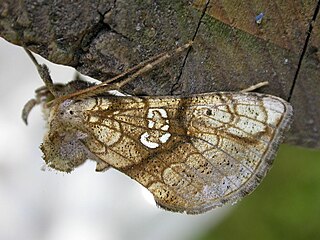
Polychrysia moneta, the golden plusia, is a moth of the family Noctuidae. It is found in the Palearctic realm.

Cerastis leucographa, the white-marked, is a moth of the family Noctuidae. The species was first described by Michael Denis and Ignaz Schiffermüller in 1775. It is found in most of Europe, east to Russia, through the Palearctic up to Japan.

Cosmia diffinis, the white-spotted pinion, is a moth of the family Noctuidae The species was first described by Carl Linnaeus in 1767. It is found in central and southern Europe, to the north it is found up to central England and the southern parts of the Netherlands. There is a disjunct population in Gotland. To the south, it is found down to Spain, Italy, Russia, northern Greece and Bulgaria. In the east, it is found as far as Lithuania and the Black Sea.
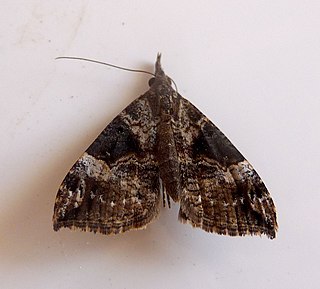
Hypena obsitalis, the Bloxworth snout, is a moth of the family Erebidae. It is found in the Mediterranean Basin including North Africa and in the Near East and Middle East, south up to the Sahara. Further north it is a migrant which occasionally establishes.

The lesser-spotted pinion is a moth of the family Noctuidae. It is found in central and southern Europe, north to Great Britain, Denmark, southern Sweden up to Saint Petersburg. East, its range extends through northern and Central Asia up to Japan. It is also found in north-western Africa.

Agrochola litura, the brown-spot pinion, is a moth of the family Noctuidae. The species was first described by Carl Linnaeus in 1761. It is found in Europe and the Middle East. It is possibly also present in North Africa, but this is unclear because similar looking species Agrochola meridionalis is found there.

Agrochola helvola, the flounced chestnut, is a moth of the family Noctuidae. It was first described by Carl Linnaeus in his landmark 1758 10th edition of Systema Naturae. The species is found in most of Europe, north to Scotland and Fennoscandia up to the Arctic Circle, south to Spain, Sicily, Greece further east to the Middle East, Armenia, Asia Minor, western Turkestan and central Asia up to central Siberia.
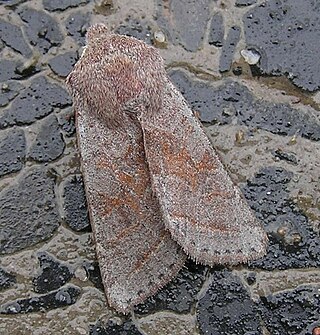
Orthosia opima, the northern drab, is a moth of the family Noctuidae. The species was first described by Jacob Hübner in 1809. It is found from central and northern Europe east to central Asia. In the west and north it is found from France through Great Britain up to southern Fennoscandia, south from the Alps up to the Balkans.

Lithophane socia, the pale pinion, is a moth of the family Noctuidae. The species was first described by Johann Siegfried Hufnagel in 1766. It is found throughout western Europe from Spain to central Scandinavia then east across the Palearctic to Siberia, the Russian Far East and Japan.
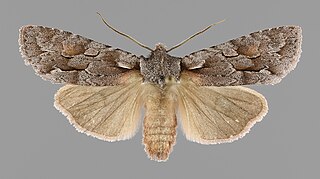
Lithophane lamda, the nonconformist, is a moth of the family Noctuidae. It is found throughout Europe, except in southern Europe. It is also absent from Iceland and Ireland.

Orthosia gracilis, the powdered Quaker, is a moth of the family Noctuidae. It is found in all of Europe except the extreme north and south, then east across the Palearctic to Northern Asia and Central Asia. O. g. pallidior is described from Xinjiang in China.
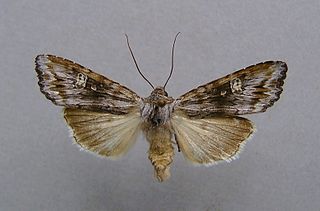
Lithomoia solidaginis, the golden-rod brindle, is a moth of the family Noctuidae. The species was first described by Jacob Hübner in 1803. It is found in most of Europe, except the Iberian Peninsula, Ireland, Iceland and the western and southern part of the Balkan Peninsula. Then eastwards to the Urals, Kamchatka and Japan.In the Alps it rises to about 1500 meters. It is found mainly on marshy ground, in humid mixed forests as well as in tundra - and taiga areas.





















